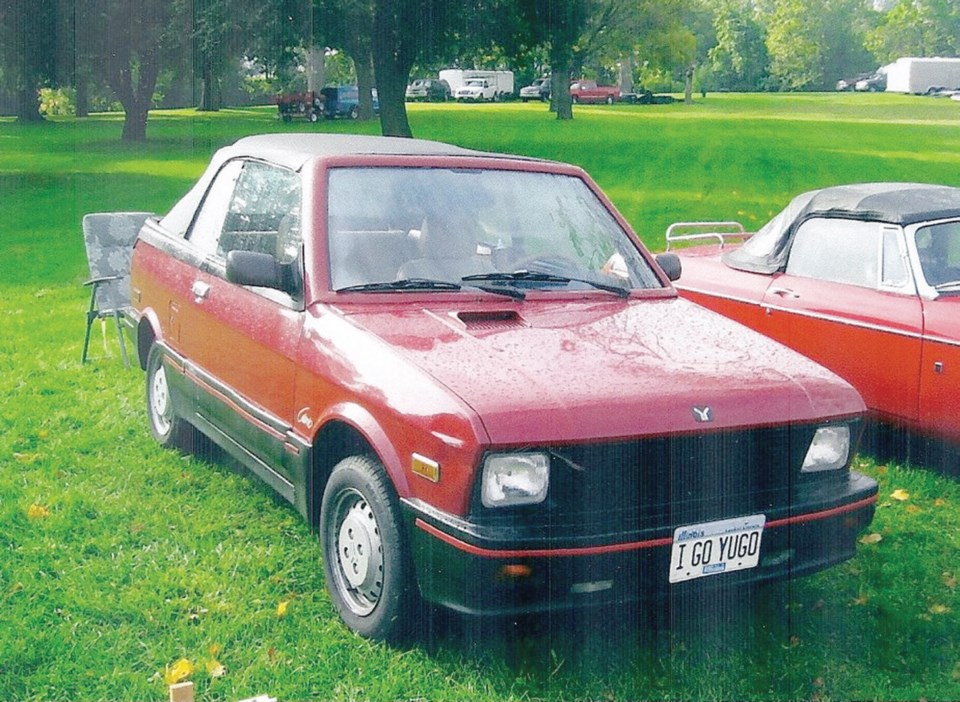Few cars have been as ridiculed as the Yugo GV (for Great Value). The Edsel suffered more than its share of the slings and arrows of negative publicity, as did the Chrysler/DeSoto Airlfow before it and the Lada and Pontiac Aztec after, but none quite so much as the Yugo.
It didn’t start out that way. When the Yugo arrived on the North American scene in the 1980s, it generated an initial surge of goodwill and enthusiasm due to its low price of $3,990 US. But it soon became apparent that the Yugo was too basic for most North American tastes, and proved so troublesome it soon lost favour. It became somewhat of an automotive farce and the butt of many jokes, such as: “Why does the Yugo have a rear-window defroster? To keep your hands warm when pushing it.”
The Yugo was produced by the Zastava Group in the city of Kragujevac, Serbia, one of Yugoslavia’s oldest industrial complexes. It built its first Yugo prototype in 1978 based on the Fiat 128, a small, four-passenger, front-wheel-drive hatchback. Production started in 1980.
The Yugo began arriving in the United States in 1985, imported by Malcolm Bricklin’s International Automobile Importers that had previously brought in the Fiat X1/9 and Fiat 2000 Spider after Fiat ceased production. Coachbuilders Bertone and Pinanfarina took over building them and Bricklin sold them under the names Bertone X1/9 and Pinanfarina Spider.
Bricklin was familiar with offbeat cars. In 1968, he and a partner began importing the tiny Japanese two-cylinder Subaru 360 to the United States. This was prompted by the discovery that its weight of less than 454 kilograms meant it was not considered a car in the U.S. and was exempt from American safety legislation.
When Consumer Reports magazine tested a 360 and declared it the most unsafe car in America, sales dried up. Bricklin later established Bricklin Canada in New Brunswick where he manufactured the fibreglass-bodied Bricklin gull-wing sports coupes for a year before going broke, leaving Nova Scotians with a huge bill.
The Yugo was a small car, measuring just 3,531 millimetres long with a 2,184-mm wheelbase and weighing 844 kg. Power came from a 1.1-litre inline four with a belt-driven single overhead cam. The little engine produced 55 horsepower and drove the front wheels through a four-speed manual transmission.
When the Yugo was tested by U.S. car magazines, it came in for mixed but mostly negative reviews. Car and Driver, not surprisingly, was the most disparaging, calling it a “cheap, no-frills appliance” that was the “Revenge of the Kmart shoppers.” They found performance modest with zero to 97 km/h in 14 seconds and top speed of 139 km/h. They reported a mediocre 25 miles per U.S. gallon in what they admitted was spirited driving.
They concluded that “the average C&D reader would regard the Yugo not as a real car but a carlike curiosity.” The technical editor said: “It’s obvious that the Yugo GV is inferior to every other car sold in America,” and concluded that he would rather buy a two-year-old Chevette. They acknowledged that it was easy to park.
Consumer Reports, in their austere, beady-eyed style, gave it a much-worse-than-average rating in virtually every category from body to transmission, all based on reader feedback. In their test they found its drivability — starting, warm-up, acceleration — poor, its seats uncomfortable, driving position awkward, interior noisy, etc. Needless to say, it was not recommended as a Best Buy.
Road & Track, with its small-car bias and less irreverent style than Car and Driver, was as kind as possible but it was obvious they found it very basic and generally obsolete by world small car standards. They were also hesitant about importer Bricklin’s reputation, saying “when you consider the track record of its importer (Bricklin/IAI) the parts and service situation may not be the most nurturing a few years down the road.”
In an attempt to increase desirability, a 1,300-cc model was offered later, as was an automatic transmission and air conditioning. It was not enough, however, and the Yugo left the American scene in 1991 when annual sales had slid to less than 4,000 cars.
In spite of its shortcomings for the American market, more than 140,000 Yugos were sold there from 1985 to ’91. Its best year was 1987 with about 48,000, proving that price is a strong motivator for many buyers, as Hyundai’s Pony showed in Canada in the 1980s. The Yugo was produced from 1985 to 2008, during which almost 795,000 were built. It was particularly popular in Serbia.
